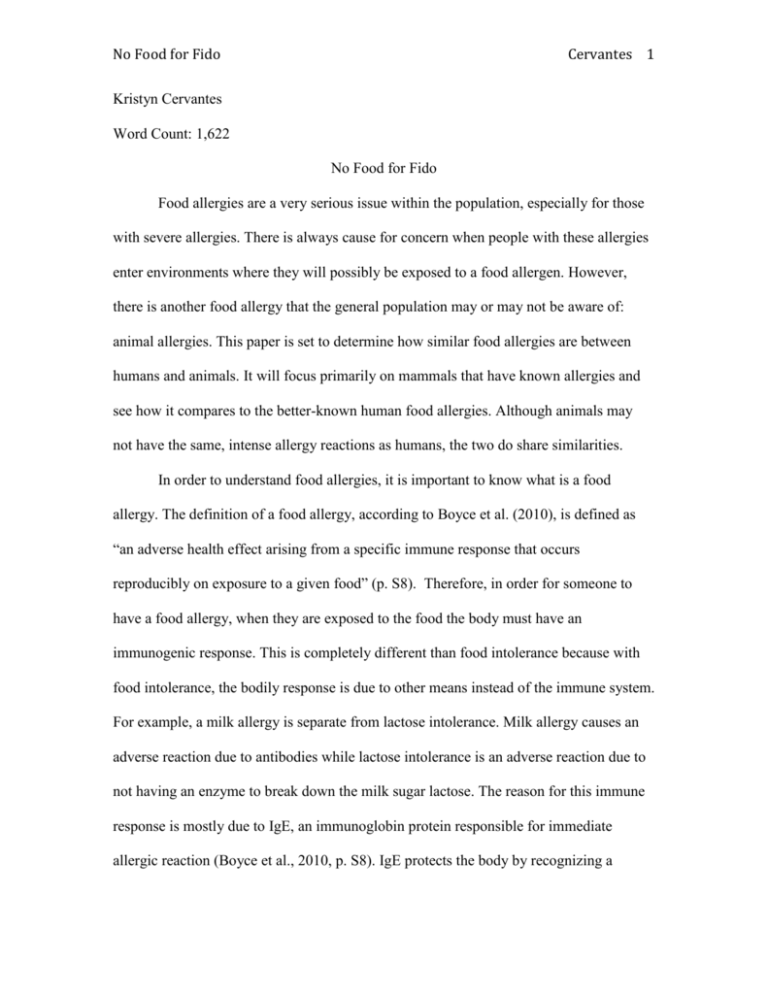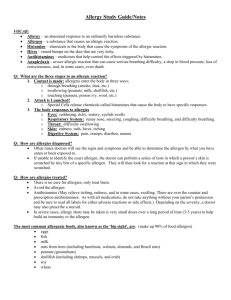Assignment4 - WordPress.com
advertisement

Cervantes 1 No Food for Fido Kristyn Cervantes Word Count: 1,622 No Food for Fido Food allergies are a very serious issue within the population, especially for those with severe allergies. There is always cause for concern when people with these allergies enter environments where they will possibly be exposed to a food allergen. However, there is another food allergy that the general population may or may not be aware of: animal allergies. This paper is set to determine how similar food allergies are between humans and animals. It will focus primarily on mammals that have known allergies and see how it compares to the better-known human food allergies. Although animals may not have the same, intense allergy reactions as humans, the two do share similarities. In order to understand food allergies, it is important to know what is a food allergy. The definition of a food allergy, according to Boyce et al. (2010), is defined as “an adverse health effect arising from a specific immune response that occurs reproducibly on exposure to a given food” (p. S8). Therefore, in order for someone to have a food allergy, when they are exposed to the food the body must have an immunogenic response. This is completely different than food intolerance because with food intolerance, the bodily response is due to other means instead of the immune system. For example, a milk allergy is separate from lactose intolerance. Milk allergy causes an adverse reaction due to antibodies while lactose intolerance is an adverse reaction due to not having an enzyme to break down the milk sugar lactose. The reason for this immune response is mostly due to IgE, an immunoglobin protein responsible for immediate allergic reaction (Boyce et al., 2010, p. S8). IgE protects the body by recognizing a No Food for Fido Cervantes 2 foreign invader and calling a response. Unfortunately, with allergens, IgE does not identify it as a safe substance and calls the response, despite putting the individual in potential danger. There are several known food allergies in humans that occur due to IgE: milk, egg, peanut, tree nuts, fish, crustacean shellfish, wheat, and soy (Boyce et al., 2010, p. S16). These are the most common food allergies in the population. However, some people do manage to outgrow their allergy. Those who do not outgrow it always need to be mindful of what they eat in order to prevent a potentially fatal reaction. While animals may not have to worry about a response that severe, it is a bit more difficult than the relatively obvious human response. Animal food allergies are a little more complicated than human allergies. One of the obvious reasons is because animals cannot vocally tell humans if they are in pain. Instead, people need to depend on any behavioral changes or external symptoms that may arise. Generally for mild allergic reactions, food related or not, the reaction causes the animal to scratch itself (American Society for the Prevention of Cruelty to Animals [ASPCA], 2013). This is due to the fact that typically IgE elicits an inflammatory immune response. With more severe reactions, the immune response causes more damage to the animal. However, reactions can vary from animal to animal and even species to species. More severe reactions could be vomiting and diarrhea (Simpson, 2013) to, while rare, anaphylactic death (Cole & Dees, 1963). Of course, how the allergen affects the animal all depends on the animal and its immune response. This is where research with the different animals and allergens come into view. Throughout the years, different areas of research on different allergies were conducted. There are more recent studies due to the growing concern of food allergies No Food for Fido Cervantes 3 and how it affects every single living thing. Knutsen (2013) describes how a study in the 1960s about how all milk proteins gave the guinea pigs an allergic response and how other recent research tried to link the guinea pigs to children and their allergic response. Scientists and researchers are continually researching about food allergies and how they compare to other species. There is even research on how evolutionary genetics may play a part in IgE expression. In the study about IgE expression in primates, humans with normal immune functions have low values of IgE serum due to a certain IgE gene expression while Old World monkeys and non-primate do not have that particular segment (Wu et al., 2012). Since these animals don’t have that particular expression, the IgE is not as prevalent compared to the animals and humans that have the expression. IgE in primates promotes a main role in immune defense. In order to find out what animals are allergic to, certain tests are needed. An example of this is a patch test. A patch test helps uses different animals, in this case dogs, and puts different food items on the skin to see if contact with the food causes an external reaction. Another way to find an allergic reaction is to test for IgE and another immunoglobulin, IgG (Bethlehem, Bexley & Mueller, 2012). This test is more conclusive than patch testing due to the fact that blood work tends to be more accurate because it is able to have a quantitative value. Not only will serum testing show what the animal is allergic to, it will also show severe the reaction will be. As long as either the patch test or serum test result in a positive reaction, the animal is allergic to whatever the foodstuff it was in contact with. After all the research is done, it is then when the similarities between humans and animal allergies start to surface. Even though humans and animals seem to be different physically and No Food for Fido Cervantes 4 physiologically speaking, there are actually very few differences between the two. Usually the allergen must be ingested to show a response, although it is possible have a reaction just by coming in contact with the allergen. It is clear seeing the patch test study done by Bethlehem, Bexley & Mueller (2012). It is not very practical for humans to use the patch for routine checks, but for general knowledge it can be accomplished with either humans or animals. So it’s not surprising that there are allergens that cause reactions for both humans and animals. Cole and Dees (1963) did a study and found that all milk proteins cause some version of an allergic reaction. A similar study was done with children using roughly the same materials and found that children also go through the same sort of reaction. However, it is possible to desensitize the allergy through oral transmission (Nadeau, Schneider, Hoyte, Borras & Umestsu, 2011). Taking a look at common dog food allergies “including beef, chicken, pork, horse, lamb, fish, egg, milk, rice, wheat, oatmeal, corn, and soy” (Liestra, Markwell & Willemse, 2001, p. 1411), there are similar allergens in humans. It is possible that the same process happens between these two species. There is even another allergen that people and now a schnauzer share. According to Kang & Park (2012), the dog is the first recorded to have an allergic reaction after ingesting a peanut. This is another link between human and animals with similar allergens, whether or not this is a new allergy for dogs. Just like with humans, the veterinarians say that avoidance is the best prevention. While there are some clear similarities between animals and humans with food allergies, there are several differences as well. Obviously, with animals their reactions are not normally as fatal as some of the human reactions. But for the animals, it is still an uncomfortable experience. “Nausea, vomiting, urticaria, angioedema, progressive No Food for Fido Cervantes 5 respiratory symptoms, hypotension, and dysrhythmias may develop within minutes to a few hours after ingestion of the food” (Kang & Park, 2012, p.1203). Animals still go through terrible experience after they ingest an allergen. What’s worse is that the animals cannot take care of themselves; they must depend on their caretakers. They do not have the luxury of personally avoiding allergens like humans can. Animals also may have different allergens than humans. For example, in the ASPCA’s (2013) page about dog allergies mentions that they can be allergic to the proteins in beef, chicken, and pork. Although humans can also be allergic to those items, it is not as common as it is in dogs. There are some proteins that are more easily read as a safe substance to us, but not animals. People need to be careful and make sure that the animals in their care are being well taken care of. Despite a difference in appearance and different responses, food allergies between humans and animals are actually similar. Since food allergies are defined with an immune response after typically ingesting a particular food item, both humans and animals clearly show that response. Discovering what and how animals are allergic to a certain type of food group is a little more difficult than humans, but it is still possible. In order to see what the animal is allergic to may take some research. For some animals, all the components of the food can be what the animal is allergic to. While other times it can be just a certain protein that causes the immune response. For certain food, humans and animals can share the same allergen. There are animals with known allergic responses to milk, soy, wheat, and possibly peanuts. Perhaps research trials to see if animals can be desensitized to their allergies similar to humans should be studied. Animals may not have the same severity when it comes to food allergies, but it should be taken into account as a No Food for Fido Cervantes 6 problem. No matter what the species, people must be mindful of allergies and aware of how they exist. Every being deserves to be taken care of and be able to live a comfortable life without the anxiety that comes with food allergies. Cervantes 7 No Food for Fido References American Society for the Prevention of Cruelty to Animals. (2013). Allergies. Retrieved from http://www.aspca.org/pet-care/dog-care/allergies Bethlehem, S., Bexley, J., & Mueller, R. S. (2012). Patch testing and allergen-specific serum IgE and IgG antibodies in the diagnosis of canine adverse food reactions. Veterinary Immunology and Immunopathology, 145, 582-589. Boyce, J. A., Assa’ad, A., Burks, A. W., Jones, S. M., Sampson, H. A., Wood, … & Fenton, M. J. (2010). Guidelines for the diagnosis and management of food allergy in the United States: Report of the NIAID-sponsored expert panel. Journal of Allergy and Clinical Immunology, 126(6), S1-S58. Cole, W. Q., & Dees, S. C. (1963). Allergenic properties of milk and milk proteins: A study of anaphylaxis in guinea pigs. The Journal of Pediatrics, 63(2), 256-263. Kang, M., & Park, H. (2012). Putative peanut allergy-induced urticaria in a dog. The Canadian Veterinary Journal, 53, 1203-1206. Knutsen, A. P. (2013). 50 years ago in The Journal of Pediatrics: allergic properties of milk and milk proteins: A study of anaphylaxis in guinea pigs. The Journal of Pediatrics, 163(2), 470. Leistra, M. H. G., Markwell, P. J., & Willemse, T. (2001). Evaluation of selected-proteinsource diets for management of dogs with adverse reactions to foods. Journal of the American Veterinary Medical Association, 219(10), 1411-1414. Nadeau, K. C., Schneider, L. C., Hoyte, L., Borras, I., & Umestsu, D. T. (2011). Letters to the editor: Rapid oral desensitization in combination with omalizumab therapy No Food for Fido Cervantes 8 in patients with cow’s milk allergy. Journal of Allergy and Clinical Immunology, 127(6), 1622-1624. Simpson, L. (2013). Canine food allergies. Retrieved from https://cvm.msu.edu/hospital/services/nutrition-support-service-1/clienteducation/canine-food-allergies Wu, P. C., Chen, J., Kawamura, S., Roos, C., Merker, S., Shih, C., … & Chang, T. W. (2012). The IgE gene in primates exhibits extraordinary evolutionary diversity. Immunogenetics, 64, 279-287.






